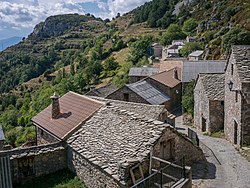Village
A aldea (in Arabic: aḍ-ḍayʿah (الضيعة) 'the farm'), also called a caserío in some regions of Spain and Latin America, is a settlement common human located in rural countryside areas. It is generally smaller in size and population than a town. Villages have been the fundamental unit of human communities in most areas of the world throughout history; from its appearance in the Neolithic (appearance of agriculture until after the Industrial Revolution and the current process of Urban Revolution, in which industrial society replaced pre-industrial society. They are maintained in areas of dispersed population, such as oceanic climate zones of Europe and whose territory organization corresponds to Germanic criteria (Galicia, Asturias, Brittany, British Isles...), where it was easy to find water.In many American states, a specific type of independent municipal government is called a village.
The medieval village
Medieval villages were built around a castle or a parish church. Around the village were the cultivated lands, which were arranged in concentric rings. In the first ring, immediately to the houses, were the small family gardens. In the second, the vineyards, olive groves and cereal fields. The limits of the term corresponded to the forest, which occupied a large extension and was a pantry of fruits, firewood and animals.
Some of the best-known examples of villages are those of the Aragonese Extremadura, that is, the lands of southern Aragon during the Reconquest. These villages were grouped into the so-called Communities of Villages, such as the Community of Teruel, where Escorihuela stood out for the so-called Escorihuela Judgment, a lawsuit that is considered the origin of municipal independence in Aragon.
The village in present-day Spain
In Spain, the village is one of the categories used in the gazetteer of population entities. In the Order and Instruction of 1930, for the elaboration of the gazetteer of that year, the village was defined as:
the entity of smaller neighborhood and population, often more widespread than the place, but whose buildings are also sometimes forming streets and squares. The word village envelops the dependence of another entity.
The village in the United States
Incorporated Villages
In twenty states, the term "village" (hamlet or village) refers to a specific form of municipal government, similar to a city but with less authority and geographic scope. This means that, in many states, there are villages that are larger in magnitude than the smallest cities in the state. The distinction is therefore not based on population, but on the relative powers granted to the different types of municipalities, which must provide specific services to their residents.
In many states, such as New York, Wisconsin, or Michigan, a village is an incorporated municipality, usually, but not always, with a single city. Residents pay taxes to the village and the city and can vote in elections for both. In some cases, the village may be coextensive with the city. There are also villages that cross the limits of a city.
There is no population limit for a village in New York. So, for example, Hempstead, the largest village in the state, has a population of 55,000, more populous than many cities in the state. However, villages in the state cannot exceed 13 km² (square kilometers) in area.
The state of Wisconsin has a similar status for villages. The largest village is Menomonee Falls, which has more than 25,000 residents. Michigan also has no population limits for villages, and there are several villages larger than other cities in the state.
Unincorporated Villages
In several states, the term "village" refers to a relatively small unincorporated area. This informal usage can be found in states that have villages as incorporated municipalities, although it is considered incorrect and misleading.
Contenido relacionado
2nd century
Saskatchewan
History of africa

